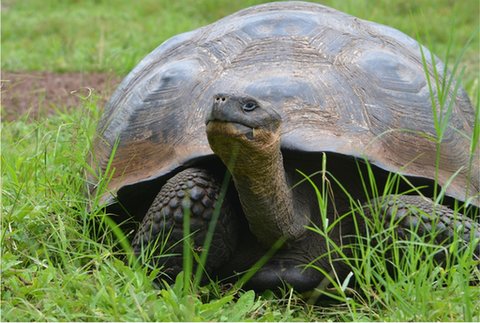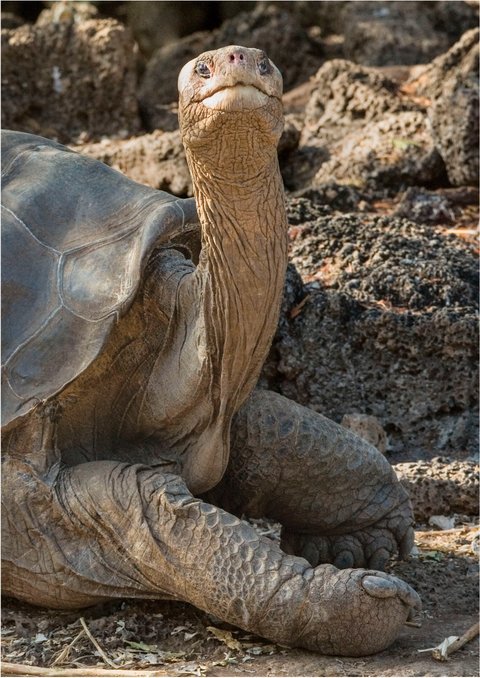LandofGiants
Perhapsthemostwell‑knownspeciesoftheGalápagosisthegianttortoise.InDarwin’stime,some15speciesexisted.Today,11species remain.
Eachspeciesissuitedtosurviveonitsisland.Thosewithdomedshellscanbefoundinhighlandswithfertilepastures.Theirshellshapekeepsthemfromraisingtheirheadshigh.So,theyneedtofindfoodclosetothe ground.
Thosewithsaddlebackshells—orshellswithanupwardcurveatthefront—canmorefreely stretchtheirnecks.Theyliveonislandswithsparsevegetation.Theirshellshapeallowsthemtoreachforfoodthat’shigheroffthe ground.

Galápagosgiant tortoise

gianttortoisewithsaddleback shell

gianttortoisewithdomed shell
AtRisk
Sadly,oneofthetortoise’sgreatestadaptationsbecameacauseofitssteadydecline.Gianttortoisescansurvivefornearlyayearwithoutfoodorwater.Sailorsandwhalerswouldcollectthemfromtheislandstohavefreshmeattoeatonlongvoyages.Tortoiseswerealso exploitedfortheirfat,whichwasusedinlamps.Asmanyas200,000tortoiseswerekilledforthesepurposesfortwocenturies.Thosethatsurvivedontheislandsweresubjectto predators.
In1959,the GalápagosNationalParkandtheCharlesDarwinFoundationwerecreated.Soonafter,theTortoiseBreedingCenteronSantaCruzwas established.
TortoisesToday
Toslowthelossofgianttortoises,theTortoiseBreedingCenterbeganraisingcaptivetortoises.Oncethey’vegrownlargeenoughthatpredatorswon’tposeadanger,thecenterintroducesthemintothewild.Bytheendof2017,morethan7,000youngtortoiseswerereturnedtotheirislandof origin.
Onegoalistorepopulatetheislandswheretortoiseshavegone extinct.ThishappenedonFloreanaandSantaFeinthemid‑1800sandonPintaIslandin2012,withthedeathofLonesomeGeorge.Today,SantaCruzandIsabelahavethelargestpopulationofgianttortoises.Theirnumberscontinueto grow.
WhoWasLonesomeGeorge?
ThePintaIslandtortoisewasextinct.Thatwasafact.Noonehadseenoneontheislandsince1906.Thenin1971,a scientistdiscoveredoneby accident.ThattortoisewasLonesomeGeorge,oneoftherarestcreaturesintheworld.GeorgewasmovedtotheCharlesDarwinResearchStationonSantaCruzandlivedtherefor40years.Hewasabout100yearsoldwhenhedied.Theworldfelthisloss.Georgehadbecomeanimportantsymbolforconservation everywhere.
